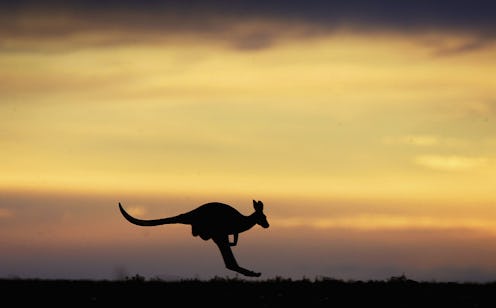News
Kangaroos Didn't Always Hop
What could possibly be better than kangaroos, our bouncing, baby-pocketed friends from down under? Giant, lumbering, fat prehistoric kangaroos, of course! Known by the ever-so-sexy technical name of "sthenurines", these distant relatives of our modern-day kangas sadly died out about 30,000 years ago — probably in part because they were so fat they literally could not hop. Seriously, they just trundled along with their teeny-weeny arms, like adorable mini T-Rexes.
Not to say they were actually mini. Relative to dinosaurs, they were tiny, but relative to us, they were huge. According to a new study published in the scientific journal PLOS One, the sthenurines were roughly eight feet tall and weighed over 520 pounds. That's about three times the size of the modern day kangaroos we know and love.
Kangaroos are, of course, not the only creatures with awesome, giant ancestors. Recent research has unearthed the six-foot-tall six ancient penguin, which roamed around the Antartic 37 to 40 million years ago; the terrifying Argentavis bird (which had a wingspan up to 26 feet and weighed a whopping 240 pounds); and prehistoric sloths the size of elephants. All of these creatures were — or at least sound like they were — fearsome and intimidating. Not so the big, waddling sthenurines — they were about as awkward as their name name makes them sound.
They had short, flat, rabbit faces, little arms, and — rather than make them mighty — their size was an unfortunate impediment. They were just too big to bounce along, and so instead they walked. Slowly, lumbering, like your drunk Uncle Mikey after Thanksgiving dinner. Explained study author Professor Christine Janis to The Telegraph:
Hopping is a tricky gait, and modern kangaroos are near the limit, in terms of size. At best, they'd have been really clumsy hoppers ... I don't think they could have gotten that large unless they were walking. We need to consider that extinct animals may have been doing something different from any of the living forms, and the bony anatomy provides great clues.
Janis is basing her conclusions on several years' work looking at over 140 kangaroo and wallabee skeletons. According to the bone structures she and her researchers analyzed, the sthenurines stood upright, and, because of their large knees and hips, they were likely able to support themselves on one foot at a time. Add that to the fact that these dudes were big (and I mean, really big), and the fact that their spines and tails were super rigid they probably walked — or rather waddled, on two legs.
Sadly, this for sure would have impacted their survival. The prehistoric kangaroos were walking their heavy, waddling walk through the Australian outback roughly 100,000 years ago, and only became entirely extinct some 70,000 years after that — in the meantime, humans got to Australia roughly 60,000 to 40,000 years ago, and we were speedy, cunning creatures. Those slow, loping sthenurines didn't have a hope.
Images: Getty Images
